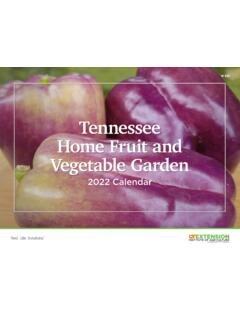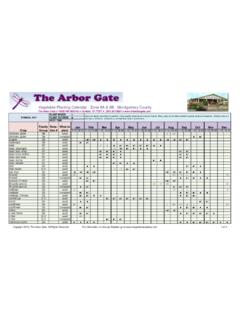Transcription of HOW TO START A VEGETABLE GARDEN - Old Farmer's …
1 HOW TO START A. VEGETABLE GARDEN . FREE BEGINNERS GUIDE TO GARDENING. 1 THE OLD Farmer's ALMANAC. INDEX. HOW TO START A VEGETABLE GARDEN . FREE BEGINNERS GUIDE TO GARDENING. 5 GARDEN PLANNING CHOOSING WHICH VEGETABLES TO FREE SAMPLE GARDEN BENEFITS OF GARDEN PLANNING CHOOSING A LOCATION FOR YOUR SOIL PREPARATION: BUILDING THE SOWING TRANSPLANTING IN THE PLANT GROWING GARDEN RAISED BED CONTAINER GARDENING ..19. PREPARING YOUR GARDEN FOR 1 THE OLD Farmer's ALMANAC. LEARN MORE. HOW TO START A VEGETABLE GARDEN . Are you wondering how to fit gardening into your life? START small! With a bit of planning, you can master the basics and then go beyond. In this guide, you will find everything you need to know to make a GARDEN grow. So, roll up your sleeves and read on! 5 GARDEN PLANNING TIPS. WHERE TO START ?
2 HERE ARE 5 TIPS TO CONSIDER: 1. Space is often the biggest limitation. Think about how much space you have for growing. Once you select your vegetables, you will notice that some plants take more room to grow than others, and you will need to make some choices. For example, corn needs a lot of space and can over-shadow shorter vegetables. Plants set too close together compete for sunlight, water, and nutrition and fail to mature. If you are tight on room, remember you can always grow vegetables in con-tainers. 2. Length of the growing season in your region is very important. If you live in the far North, some vegeta- bles may not mature during your growing season. The Almanac lists the first and last frost dates for your season: View calculator for sowing and planting dates by location and frost dates.
3 3. Seriously think about how much time you have to devote to your GARDEN . For example, bush beans grow prolifically with little care. Radishes almost grow themselves. However, tomatoes will require staking and pruning. (We have more information on easy-to-grow crops below!). 4. Understand the timing of harvest. For example, warm-season vegetables such as peppers will START later than cool-season vegetables such a lettuce and broccoli. (More on which vegetables to choose later.). 5. Test out the Almanac GARDEN Planner software. We've done the research for you. The planner calculates how many vegetables fit in a space, as well as the planting and harvesting dates for every VEGETABLE ! It will save you a lot of headaches (and money) and yield bigger harvests. Go here to try the GARDEN Planner for free for 7 days: CHOOSING WHICH VEGETABLES TO GROW.
4 Only grow things that you like to eat. There's no sense in cultivating veggies destined for the compost heap. The vegetables suggested below are common, productive plants, but you'll also want to con-tract your local cooperative extension to determine what plants grow best in your local area. Think about what you like to eat as well as what's difficult to find in a grocery store or farmers ' market. Tomatoes 5 plants staked Zucchini squash 4 plants Peppers 6 plants Cabbage Bush beans Lettuce, leaf and/or Bibb Beets Carrots Chard Radishes Marigolds to discourage rabbits! (Note: If this GARDEN is too large for your needs, you do not have to plant all 11 rows, and you can also make the rows shorter.). 3 THE OLD Farmer's ALMANAC. FREE SAMPLE GARDEN PLANS. Here's a tip: A good-size beginner VEGETABLE GARDEN is about 16x10 feet.
5 A plot this size, based on the easy vege- tables suggested above, can feed a family of four for one summer, with a little extra for canning and freezing (or giving away). Make your GARDEN 11 rows wide, with each row 10 feet long. The rows should run north and south to take full advantage of the sun. SAMPLE PLANS FROM ALMANAC GARDENERS! 1. Backyard GARDEN Plan: Traditional Rows GARDEN Size: 29' 11 x 29' 11 . GARDEN Type: Backyard / back GARDEN GARDEN Layout: Traditional layout - rows etc Sun or Shade: Sunny See plant lists and more details about this GARDEN here. 2. Backyard GARDEN Plan: Raised Beds GARDEN Size: 23' 11 x 23' 11 . GARDEN Type: Backyard / back GARDEN GARDEN Layout: Raised Beds Sun or Shade: Sunny GARDEN Soil Type: Good soil See plant list and more details about this GARDEN here.
6 3. Backyard GARDEN Plan: Traditional Rows GARDEN Size: 25' 0 x 15' 11 . GARDEN Type: Home GARDEN GARDEN Layout: Traditional layout rows Sun or Shade: Sunny GARDEN Soil Type: Heavy / Clay soil See full plant list and more details about this GARDEN here. 4. Small GARDEN Plan: Raised Beds GARDEN Size: 50' 0 x 21' 11 . GARDEN Type: Home GARDEN GARDEN Layout: Raised Beds Sun or Shade: Sunny GARDEN Soil Type: Good soil See full plant list and more details about this GARDEN here. You will find hundreds of free GARDEN plans using our Almanac GARDEN Planner! 4 THE OLD Farmer's ALMANAC. BENEFITS OF GARDEN PLANNING SOFTWARE. The above plans were created using the Almanac GARDEN Planner software. We can't emphasize enough the im- portance of planning for a more productive GARDEN . The GARDEN Planner will: Help you plan where each plant goes.
7 With over 250 plants and 100 structures, you can easily identify the best positions for each plant and move them around until you get the perfect layout. Make the most of your available space. See how many plants will fit and which crops can occupy the same space in your GARDEN at different times of the year. Make sure you plant at the right times. You'll receive reminders by email when it's time to START planting, specifically for your GARDEN and your climate. We're offering a free 7-day trial ample time to play around and plan your first GARDEN . Go here: 5 THE OLD Farmer's ALMANAC. CHOOSING A LOCATION FOR YOUR GARDEN . Whether you're starting a new GARDEN or extending an existing one, give careful consideration to where to site it. The right location gives your crops the best chance of success.
8 When choosing a site, note the following environ- mental conditions: Sun Pick the right site. Most vegetables need at least 6 hours of sunlight a day, although some crops, such as broccoli, lettuce, spinach, and other greens will grow well in less sunny spots. In general, the more sunlight they receive, the greater the harvest and the better the taste. Tip: In cooler climates, a suntrap is ideal for tender crops. In hot climates, growing under shade cloth or in the shadow of taller climbing plants, such as pole beans, helps to expand the choice of what you can grow in these conditions. Also, avoid planting crops near large trees which will not only cast shade, but compete with your vegetables for nutrients and water. Air Circulation Good airflow will encourage sturdy growth in your plants and help keep fungal diseases at bay.
9 It also makes the GARDEN less hospitable to insect pests such as whitefly that prefer a stag-nant, humid environment. Bear in mind that solid walls or fences may provide shelter but they can also cause the wind to form destructive turbulence on the leeward side, so don't plant too close to them. Hedges and open or woven fences are more effective, as they filter wind rather than deflect it. Shelter from winds is helpful for most crops, especially peppers, eggplant, peas, beans, and any climbing vegeta- bles. Moisture Be sure water is readily available. Nothing burns out a beginning gardener faster than having to lug water to thirsty plants during a heat wave. Extra water is likely to be necessary during dry weather, so locate new beds close to an outdoor water source. The soil near walls, fences, and under overhanging trees tends to be too dry for good plant growth, which is why an open area is best.
10 Frost Cold air is heavier than warm air so it settles in low points in the GARDEN and near structures such as walls and fences. Avoid planting in these potential frost pockets; they can delay the time when you can START sowing seeds and they can damage young growth. 6 THE OLD Farmer's ALMANAC. SOIL PREPARATION: BUILDING THE SOIL. Good soil is the key to a successful GARDEN . Soil may be the most overlooked aspect of gardening and the most important. Good-quality soil provides plants with essential nutrients necessary to reap a good harvest. In general, the goal is to enrich soil with compost to provide needed nutrients. Compost, leaf-mould, or well- aged manure will increase the ability of your soil to both drain well and hold moisture the sponge factor.. Never use fresh manure! It can harbor dangerous pathogens and will burn tender plant roots.









